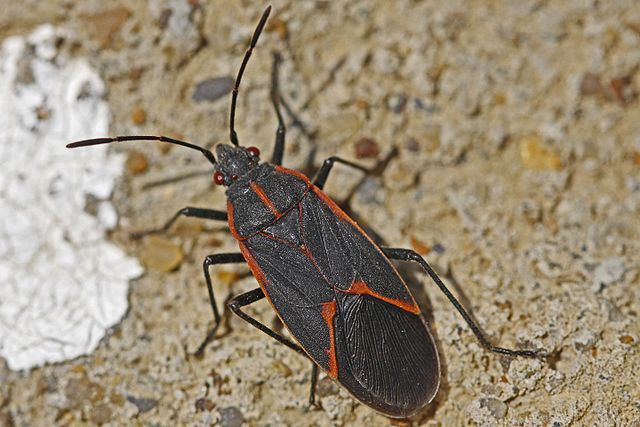-- Pest Library --
Box Elder Bug
Box Elder Bug Description
Adult boxelder bugs are about 1/2 inch long, flattened on top, elongate-oval in shape, and predominately slate-gray to black in color. Three red lines run the length of the prothorax. The top of the abdomen is red with two rows of black spots. The underside of the abdomen is alternately striped in red and gray. The legs of a boxelder bug are black.
Diet
Boxelder bugs can feed and develop on many different kinds of plants, including maple, ash, stonefruits (cherry, plum, peach), apple, grape, strawberry and grass. However, large numbers are typically found on female boxelder trees where nymphs and adults feed on developing seeds.
Life Cycle & Reproduction
In late April to early May, the bugs emerge from hibernation (about the time buds on boxelder trees begin opening). They fly back to host trees where they lay eggs in crevices in the bark of the trees and remain active over the growing season. Eggs hatch in 10 to 14 days into nymphs. The nymphs feed on foliage and seeds by inserting their piercing-sucking mouthparts into these tissues. They continue feeding until they mature into adults. When the nymphs reach the adult stage, they mate, and produce a second generation that summer. It’s the second generation of boxelder bugs that overwinter and emerge the following spring.
Habitat
Adult boxelder bugs prefer dry, sheltered areas. The congregation of the bugs on the surfaces of homes and buildings are most often related to the temperature, as the bugs prefer warm surfaces. For this reason, they are often found in large numbers on the south and/or west side of houses or other buildings. They are also found around the foundations and windows of buildings, or in leaves and other debris, under hedges, or similar places. During the winter months, adults can become active on warm winter days and emerge from their hiding places, returning to shelter as temperatures drop at the end of the day.
Threat
The boxelder bugs frequently becomes a nuisance pest around homes and buildings, but rarely cause economic, aesthetic or structural damage. Although boxelder bugs are active throughout the summer, they do not generally become big nuisance until late summer and fall (particularly on the southern and west facing walls). Boxelder bugs do not bite, sting or eat food products, but they can stain carpet and other fabrics.










